
Panchaitee tadjah, St. James, Hosay 2006
I get down to Western Main Road at about half past four, just in time to see the first tadjah cross Long Circular Road and enter St. James proper, as the Hosay procession returns from the prayer ceremony at the Queen's Royal College grounds in St. Clair. (The location seems odd only until you realise that Hosay in St. James predates the founding of QRC by a couple of decades, and until the end of the 19th century what became the college grounds was open pasture.) The tadjahs have been out since early afternoon, proceeding from their respective yards to QRC via Serpentine Road; now, as the afternoon heat recedes and a lovely dry-season breeze sighs down from the hills, a crowd is gathering to watch the end of the procession.
One by one, heralded by their tassa sides and escorted by their supporters, the five tadjahs slowly nudge forward; their order of precedence is supposed to be determined by the seniority of the five "families" who build them and follow the traditional rituals: Cocorite first, then Panchaitee, Gulam Hussain, Balma, and finally Bis (short for Bisnath). At the head of the procession are the two moons, red and green: heavy fan-shaped standards perhaps six feet tall, decorated on one side with the Islamic star and crescent, on the other with ornate patterns of sequins, and crowned with peacock feathers. They represent Hussain (red moon), the grandson of the Prophet martyred at Kerbala in 680 AD, and his brother Hassan (green moon) murdered with poison eleven years earlier. (Hosay is the commemoration of Hussein's death on the 10th day of the month of Muharram in the Islamic calendar; the ceremony was brought to Trinidad by Shiite Indians beginning in 1845, groups of whom settled in St. James, which was once a village west of Port of Spain and is now the city's westernmost district.)
The moon dancers are solemn-looking men, who seem to hold themselves apart from the rest of the procession. Though the boom and peal of the tassas fills the air, the moons seem to move in auras of silence. The dancers--leather harnesses and towels padding their shoulders, shoeless feet protected by thick white socks--take turns hoisting the heavy moons on their backs and spinning them round and round: this is the dance. The strain of the weight shows on the men's faces, and the strongest of them manages just five or six spins before he surrenders the burden to his successor. Once the spinning starts, the momentum is hard to control, and sometimes the moon hurtles towards the crowd, adults scattering and children pushing.
I walk down the length of the procession and back again. I decide Gulam Hussain has the best tassa side--the most players and the most energetic, all wearing orange t-shirts that read "1846-2006 / 160 years". But Panchaitee's tadjah, gold and white, impresses me most. The tadjahs--elaborately decorated floats--represent Hussain's tomb, with minarets and domes, windows and doorways, and sequins flickering in the breeze.
A little girl in pink darts past me. Her mother laughs, talking to a friend. "Yes, her first time."
I'm halfway down Western Main Road by now, and the crowd spills from the pavement into the street, closed to traffic. Though Hosay is a Shiite holiday, the citizens of St. James have joined in, regardless of faith, for decades. The moon dancers are all Muslim, but the tassa drummers and the supporters pushing the tadjahs and the many spectators are, well, Trinidadian, which means as diverse as you can imagine. Young men with cornrows in basketball jerseys, a Hindu woman in a sari, middle-aged men in Phase II t-shirts laden with bling, Rastas in tams, teenaged girls in tight denim, old women in headscarves, men in ties and women in suits wandering from their offices, and many children clutching the pinwheels that for some reason have become a Hosay tradition. And Hosay itself has become a way to affirm a kind of community spirit, something shared by everyone in St. James.
The tassas are meant to be war drums, someone tells me, but they don't sound angry; they sound, well, joyful, though Hosay is supposed to commemorate a tragic event. And though few people dance, everyone is smiling and joking; the sky is blue and gentle, pigeons swirl overhead, and the drums are the pulse of life, not a mourning dirge or a call to battle.
As I meander through the crowd, pausing to snap a photo or look at the drummers, two thoughts simmer in my mind. First: the impossibility that Hosay and Carnival can have co-existed in Port of Spain for a century and a half without some kind of cross-pollination. My creole eyes see the tadjahs and think of kings and queens of the bands; from a distance the moons remind me of fancy Indians with their huge fan-shaped feather headdresses.
Second: the remoteness of the scene I'm in the midst of--the tadjahs' stately grace, the moondancers' dervish-like devotions, the sense of friendship and neighbourliness animating the now-thronged street, Hindus and Catholics and Protestants and Rastafarians helping to beat the drums that commemorate the death of the Prophet's grandsons--the remoteness of all this from the image of Islam that's preoccupied the world these recent weeks. And I think: this place is a mess, yes, but we've figured a few things out.
And, as happens more and more as I get older and try harder to understand the world, I think this too: I don't really want to be anywhere else.
As dusk settles, the procession breaks up and the tadjahs turn down the side streets to their yards. On Monday, Teejah Day, they'll emerge one more time, heading down to the sea at Invaders Bay, where they'll be dismantled and submerged.
The crowd of spectators has gradually turned into the usual Friday night crowd. I walk down to the far end of Western Main Road and catch a taxi, and head for home.
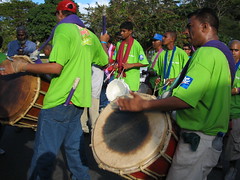
Balma tassa side, St. James, Hosay 2006
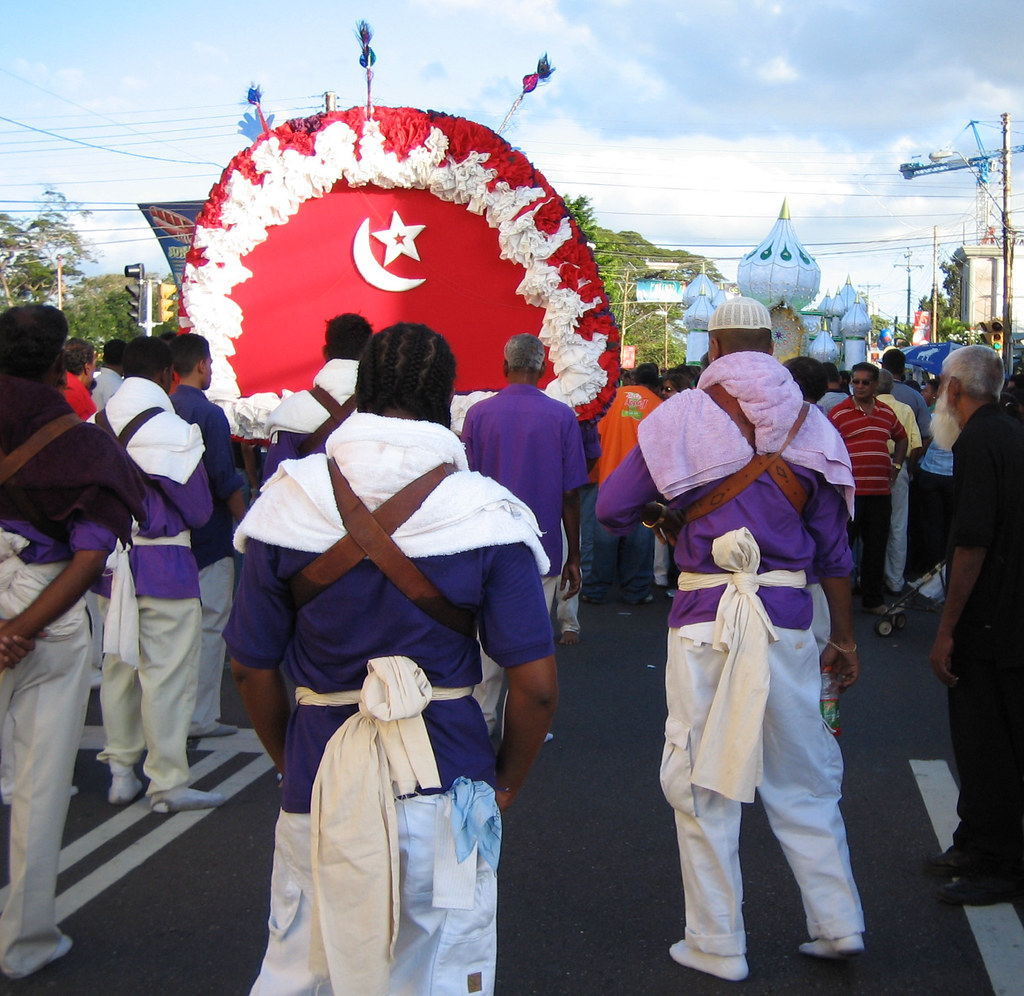
Dancing the red moon with the Gulam Hussain tadjah in the distance, St. James, Hosay 2006

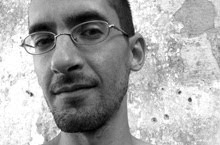




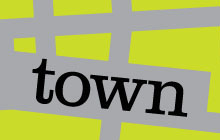

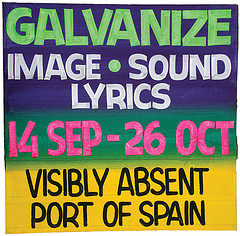
4 comments:
"the impossibility that Hosay and Carnival can have co-existed in Port of Spain for a century and a half without some kind of cross-pollination"
I once described Hosay to a foreigner who asked me, "Is it a religious celebration, or a carnival?" This being Trinidad, the answer, of course, is both.
fascinating stuff. id love to attend hosay in person some day.
i have some photos on my site of the ashura rites in bahrain if it interests you:
http://chanad.weblogs.us/?p=456
its amazing how it has evolved in the two different environments.
See what happens when you're away from the "sphere of influence", the community innovates to keep alive an occasion, and morphs it from a commemoration to a celebration.
There are indications that our own commemorations in Bahrain are being morphed into something... I'm not sure to what yet, but it seems to be a much more celebratory occasion than those I remember as a child over 30 years ago.
How do you greet each other during Ashura in T&T? Do you wish each other "ma'joureen" or something like that?
Thanks for this, Nicholas. You (T&T) definitely have something special and unique... I can't wait to see T&T again soon...
Post a Comment